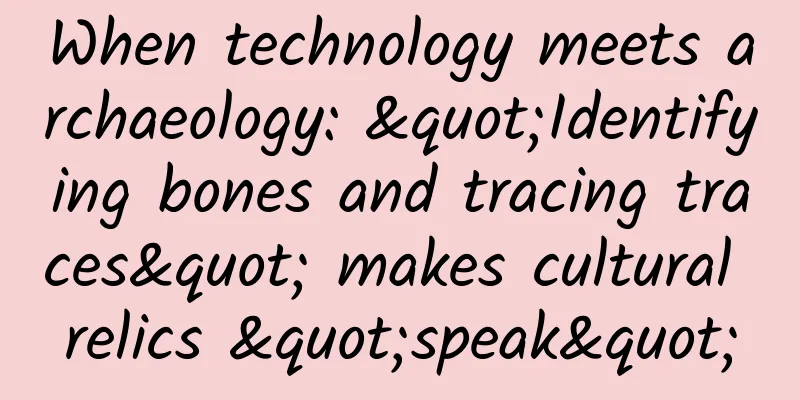When technology meets archaeology: "Identifying bones and tracing traces" makes cultural relics "speak"

|
Produced by: Science Popularization China Author: Chen Dian (University of Chinese Academy of Sciences) Producer: China Science Expo A British archaeologist once said: "The first part of archaeology is the search for ancient treasures, the second part is the careful exploration of scientific workers, and the third part is creative imagination." The ultimate goal of archaeological work is to fully explore and reasonably imagine the ancient "treasures" so as to restore the life scene of ancient society. The power of science and technology is injected into archaeology, injecting new vitality into archaeological research and making the silent cultural relics speak. In a nutshell, scientific and technological archaeology is guided by the ideas of archaeological research and applies the methods and techniques of natural sciences and other related disciplines to archaeological excavation and research. Frontier disciplines such as computer science, biology, chemistry, and geology continuously inject new technologies into the "whole chain" of archaeology, including site excavation, research and analysis, cultural relic restoration, and display and communication, playing an increasingly significant supporting and promoting role. (Left) In 1986, staff members cleaned cultural relics in the No. 2 "Sacrificial Pit" at the archaeological excavation site of the Sanxingdui Ruins; (Right) In 2021, archaeologists worked with the help of various technical equipment in the No. 3 "Sacrificial Pit" at the archaeological excavation site of the Sanxingdui Ruins. (Photo source: Chinese government website) In the field of technological archaeology, we can not only witness the intersection of ancient and modern times, experience the wonder of the integration of different disciplines, but also feel the infinite possibilities brought about by the continuous innovation of science and technology. Revealing the “Great Changes of the World”——Environmental Archaeology As human society gradually evolved, the natural environment underwent tremendous changes. Ancient people lived in different environments, which naturally raised many questions: What was the natural environment like in ancient times? What changes did it undergo? How did these environmental changes relate to human activities at the time? This is the background for the birth of environmental archaeology. Environmental archaeology restores the ancient environment based on various evidence from ancient sites , such as plants, animal remains, stratigraphic and climate data, and further studies the complex relationship between ancient society and the natural environment. Among them, settlements and livelihoods are the two aspects of human activities that are most closely related to the natural environment. Settlements refer to the places where ancient humans lived, and their choice was influenced by land conditions and safety factors. The natural environment around the settlements, such as water sources and food resources, determined the location and way of survival of the settlements to a certain extent. Water conservancy system outside Liangzhu ancient city (Photo source: The Paper) Livelihood refers to the economic activities of ancient people, including agriculture, breeding, hunting and gathering. These activities depend largely on the natural environment, such as climate, soil texture and vegetation. After the rise of agriculture, humans began to plant crops, which was restricted by climate and soil conditions. Is the environment decisive? Some people believe that the environment is only one of the influencing factors, and human activities are more dependent on cognition and decision-making. However, in any case, human activities are related to the natural environment. For example, people may choose to build a settlement in a certain place, or grow crops on a certain piece of land, which leads to a clear relationship between people and land. Through these choices, we can not only understand ancient civilizations more deeply, but also learn valuable lessons from them. Of course, environmental archaeology can also reveal climate change and natural disasters that the Earth has experienced . This knowledge and data can help us predict future environmental changes . The traces of ancient natural disasters also remind us that the power of nature cannot be underestimated. We need to plan ahead and develop effective disaster management strategies so that we can calmly respond to future challenges. "Tracing Bones" - Human Bone Archaeology and Animal Archaeology Bones include human bones and animal bones, and are one of the most common remains unearthed in archaeological sites. Archaeologists can extract and collect a lot of information from ancient remains through cleaning, packaging, measuring, statistics, and analysis. First, for human bones, researchers can identify gender and age , which allows us to understand the gender division of labor and age structure of ancient society . By further analyzing the pathology, trauma and abnormal morphology on ancient human bones, we can infer the physical health of ancient people and their interactions with other people or the environment . Bone remains with carved symbols unearthed from Erlitou excavation (Photo source: The Paper) In addition, based on the chemical composition of bones, we can learn about the dietary structure and living environment of the ancients, explore the differences in food possession, distribution, and status levels in society at that time, and whether there were certain special eating habits. As for animal bones, by observing their surface conditions, archaeologists can determine whether they have signs of being cut by a knife, hit, bitten by teeth, or morphological changes, whether the marks at the fracture are new, and then infer some of the life experiences of the owner of the bones , such as whether they were hunted and killed, or were raised and slaughtered, whether they were enslaved by humans, etc. Pig bones unearthed from the Zhongjiagang site (Photo source: Institute of Archaeology, Chinese Academy of Social Sciences) In addition to observation, archaeologists will piece together loose bones to see if they can restore the complete skeletal shape. After obtaining as much bone information as possible, archaeologists can summarize which animals were mainly unearthed in the relevant sites? What is the age distribution of the animals? What is the gender ratio? Have these animals been used by humans? This information helps to figure out how the ancients obtained meat, whether through fishing, hunting or breeding? What was the scale? Was it used for sacrifice, burial, or as a tool for riding, labor, or even a pet? All of these seemingly tiny bones carry wonderful stories. For example, horses played an important role in ancient civilizations . During the Shang and Zhou dynasties, horse bones were often found in sacrificial sites, but their burial methods were different. The Shang people usually arranged horse bones neatly because they came from the lower reaches of the Yellow River, and horses came from the northwest or north and were very precious. Staff conduct on-site identification of horse bone remains unearthed from the archaeological site (Photo source: Institute of Archaeology, Chinese Academy of Social Sciences) The Zhou people were more "luxurious" and had plenty of horse farms, so the arrangement of horse bones was more messy. This difference reflects the different attitudes of the Shang and Zhou dynasties in the use of horses. In addition, the chariot pits also provide valuable clues . The Shang Dynasty often used two horses in one chariot, while the Zhou Dynasty used four horses in one chariot. This reflects the Zhou people's more efficient military fighting style. In the Battle of Chaoge, the Zhou people defeated the Shang people, and the four-horse chariot defeated the two-horse chariot. This victory was related to the difference in their use of horses. Exploring the “Roots of Agriculture” – Plant Archaeology Unlike botany, plant archaeology aims to understand the relationship between ancient humans and plants , so as to restore the ancient people's lifestyle and explain the development and process of human culture. Plant archaeology mainly studies the ancient plant remains related to ancient human activities found in archaeological discoveries. Generally speaking, ancient plant remains are divided into two types: macro-plant remains and micro-plant remains . Macro-plant remains include plant roots, stems, leaves, flowers, fruits and seeds. Micro-plant remains include tiny plant fossils such as pollen, phytoliths and starch grains. Archaeobotany has flourished in China in recent decades and has been widely used in prehistoric and pre-Qin archaeology to explain the development of ancient human culture. Major plant remains unearthed from the Guodishan site in Yihuang, Jiangxi (Photo source: Institute of Archaeology, Chinese Academy of Social Sciences) The extraction and detection of plant remains has always been a major difficulty. In the past, manual sorting was time-consuming, labor-intensive and inefficient. The use of flotation technology is a major advancement in plant archaeology. Because dry plant remains are generally lighter than soil particles and have a lower specific gravity than water, placing flotation soil samples in water can separate most plant remains from the soil and float on the water surface. Through flotation, we have confirmed that China has a history of rice and millet cultivation that stretches back 10,000 years. Starting from the middle Neolithic Age, as the activities of the ancients expanded, the ancient Chinese agricultural model gradually evolved from "rice in the south and millet in the north" to "a bumper harvest of five grains" ("five grains" has various meanings, including millet, sorghum, rice, wheat, soybeans, hemp and other major grains). Distribution map of sites related to the origin of millet farming in the Early and Middle Neolithic period (Photo source: Institute of Archaeology, Chinese Academy of Social Sciences) Specifically, in the early Chinese civilization, millet and sorghum were the main crops of northern dryland agriculture . They grew well in the arid climate of the northern region and became the mainstay of agriculture in ancient northern China. However, as time went on, the dominance of millet was shaken. In the Central Plains, the cultivation of rice and soybeans gradually became popular, increasing the yield of grain crops. Wheat, which was adapted to cold and drought, was also introduced to northern China, leading to the development of irrigation systems in the north and accelerating the process of civilization. **The widespread cultivation of a variety of crops such as rice, wheat, millet, sorghum, and soybeans enabled China to gradually establish a diversified agricultural system. **These advances in agricultural technology strengthened agricultural productivity, contributed to population growth and the rise of cities. In addition, they also laid the foundation for the formation of political and economic centers, ultimately creating conditions for the establishment of the Qin and Han empires. “Identification of Antiquities” – Analysis of Inorganic Cultural Relics Ancient inorganic artifacts such as ceramics, metals, and jade are also important research objects in archaeology . Through scientific and technological research, we can gain a deeper understanding of the production process, historical background, and impact of these artifacts on ancient society. Ceramics played an important role in ancient civilizations. They were both practical living tools and works of art. Scientific and technological archaeology can determine the age, composition, structure, and even coloration mechanism of ancient ceramics through testing and analysis of ancient ceramics. This information helps us understand the production process, raw material sources, and cultural heritage of ancient ceramics. For example, by analyzing the chemical composition of ancient ceramics, we can trace the origin of ancient ceramics and reveal how ancient potters selected and processed clay. Qing Kangxi Jingdezhen kiln blue and white fruit tree pattern double-tube vase (Photo source: The Paper) Ancient metal artifacts , such as bronze, iron, gold and silver, represent the outstanding achievements of ancient smelting and metal craftsmanship. When studying these metal artifacts, scientific archaeology uses a variety of testing and analysis methods, combining field investigations, investigations and practices of existing traditional crafts, research on literature and materials, and restoration of ancient craftsmanship. Such comprehensive research not only helps us understand the development process of ancient Chinese metal technology, but also provides important clues for exploring cultural exchanges, technological dissemination and social development in different regions. Jade articles have a special status in Chinese culture. They are not only ornaments, but also carry religious and ritual functions. Researchers use advanced analytical techniques to determine the exact material of jade artifacts, as well as the purity and origin of the material. Through the identification of materials, we can understand the distribution of resources in ancient society and build a jade trade network. Moreover, the production of jade is a complex process involving cutting, carving, drilling, polishing, etc. Digital modeling and 3D printing technology can now be used to restore the ancient process. Internal Department of Cultural Heritage and Technology (Photo source: Official website of the Palace Museum) Conclusion The development of archaeology has increasingly relied on methods and techniques from natural sciences and related disciplines. This trend helps provide more comprehensive and accurate information, enhances our understanding of ancient civilizations, and helps preserve cultural relics and pass on cultural heritage. Scientific and technological archaeology embraces various emerging technologies, integrates professional knowledge from different fields, and plays an increasingly important role in telling the story of Chinese archaeology on the world academic stage. |
<<: If you have heel pain, don’t just bear with it!
>>: It is a "Beijing Drifter" and has gray hair at a young age.
Recommend
Technology News丨World's first 35 kV kilometer-level superconducting cable put into operation in Shanghai
【Today’s cover】 Recently, as the temperature drop...
30 things you must know about private domain!
Recently I discovered a problem, that is, many pe...
Summary of Android methods to avoid memory overflow (Out of Memory)
The method to avoid memory overflow is mainly to ...
Don't rub chopsticks back and forth when washing them? I was stunned when I saw this trending search...
Author: Gongzi Xin Recently, #Don't rub chops...
What other “hot words” will appear in the mobile phone industry in 2020?
I calculated that there is still about half a mon...
How to use data to drive product operations at different stages of product development?
Operational positions in Internet companies are g...
What happened on the day the dinosaurs went extinct? Sturgeons know the answer
Sixty-six million years ago, an ornithischian pla...
What exactly is the 2.5D glass that manufacturers are always boasting about? Is it very powerful?
Since the release of iPhone 6 last year, there ha...
A must-read for mobile app developers: 14 ways to get your app accepted by the App Store
[[161389]] 【51CTO.com Quick Translation】For devel...
[Popular Science of Chinese Military Technology] What was the first “hidden killer” planted by humans in space like?
After the launch of the first artificial satellit...
“Does artificial intelligence need to be like humans?”
Can machines think? Can artificial intelligence b...
A complete App operation and promotion plan
1. Concept of App operation and promotion Quoting...
What is data-driven design?
Data-driven design innovation is a new and import...
Modern front-end development technology stack
This article will introduce the revolutionary dev...
This is the most common model of user operation. Come and take a look. It is written in great detail!
As an operator , you must have done this: invite ...









